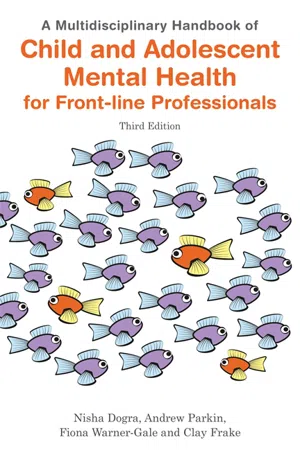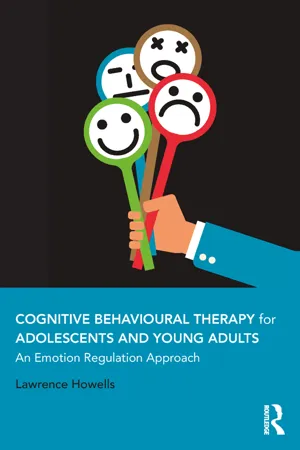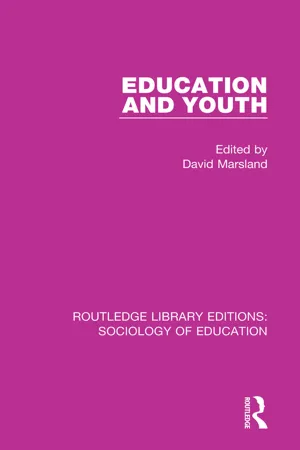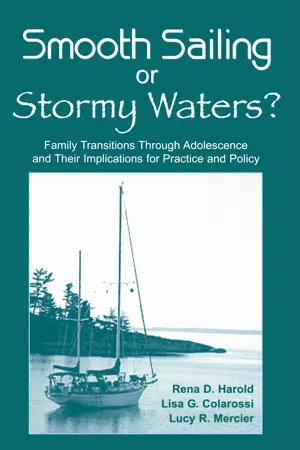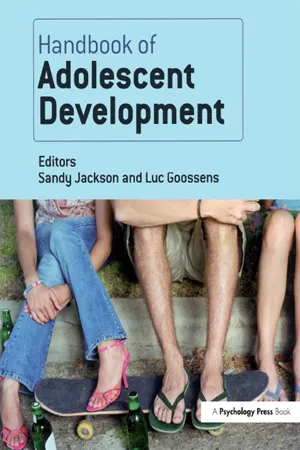Psychology
Adolescence
Adolescence refers to the transitional period between childhood and adulthood, typically characterized by physical, cognitive, and emotional changes. It is a time of identity exploration, increased independence, and the development of social and interpersonal skills. Adolescents often experience challenges related to self-esteem, peer relationships, and decision-making as they navigate this critical stage of development.
Written by Perlego with AI-assistance
Related key terms
11 Key excerpts on "Adolescence"
- Nisha Dogra, Andrew Parkin, Fiona Warner-Gale, Clay Frake(Authors)
- 2017(Publication Date)
- Jessica Kingsley Publishers(Publisher)
It is important to distinguish between the development of moral concepts and changes in behaviour. The two are usually interdependent, but both should be assessed. Adolescent developmentAdolescence is loosely defined as a period of transition from puberty (around 10–14 years of age) to late teens or early twenties. Psycho-biologically, Adolescence can be seen as associated with a process of maturation and changes in brain structure that only occur at this stage of life and that are most likely prompted by the hormonal changes of puberty, which continue into the early-to-mid-twenties. It is, however, culturally and historically variable. In Western societies, Adolescence is generally seen as a time of transition from childhood to adulthood. There may be transitions that all young people experience (such as leaving school) or some that only happen to some individuals (such as experiencing parental divorce). There may be internal changes (such as biological changes of puberty) or external ones (such as expectations of society). The changes may be normative (that is, expected to occur at a particular age physiologically or as prescribed culturally) or idiosyncratic (person specific, such as illness). The transitions may be on-time or off-time and expected or unexpected. Generally, on-time and expected changes are less disruptive than off-time and unexpected transitions. There is consistent evidence that most young people manage the transition of Adolescence without undue stress. Some of the behaviours of Adolescence may be focused on because of the discomfort they generate in adults. Media representation of adolescents can also distort the realities.- eBook - ePub
Adolescent Mental Health
Prevention and Intervention
- Terje Ogden, Kristine Amlund Hagen(Authors)
- 2018(Publication Date)
- Routledge(Publisher)
1 Adolescent development What is Adolescence? Adolescence has been described as a period of life that starts in biology and ends in society (Kagan, 1975). This portrayal indicates that the onset of Adolescence is denoted by the hormonal changes of puberty, whereas becoming an integral part of one’s social environment marks the conclusion of this period of life. For many youths, however, the description is unfitting: whilst virtually all youths go through the biological transformations of sexual maturity and increased cognitive capacity, a significant proportion of young people do not end up in society ; rather, they become maladjusted and marginalized. Youths who become marginalized, that is, end up on the outskirts of society, are the very youths this book is about. They show maladaptive and dysfunctional behavior and they can teach us much about how to intervene and how to prevent such problems in future generations of adolescents. Adolescence is the period between childhood and adulthood and is often referred to as the teenage years. The period is divided into early (11–13 years), mid- (14–16 years), and late (17–19 years) Adolescence. Historically, Adolescence has expanded in length, probably due to teenagers’ increased time spent in school and decreased time spent in the work force during this period. Adolescence has been described as a period of reconstruction, characterized by significant changes in biological, cognitive, social, and emotional systems. To some extent, adolescent development is fairly predictable in the sense that most young individuals experience similar changes in multiple systems and face many of the same developmental challenges. Yet, in other ways, development is utterly idiosyncratic - eBook - ePub
Understanding the Life Course
Sociological and Psychological Perspectives
- Lorraine Green(Author)
- 2016(Publication Date)
- Polity(Publisher)
Initially within this chapter, early psychological claims of Adolescence as a ‘naturally’ traumatic developmental stage are evaluated, followed by an analysis of physical, cognitive and psychosocial changes. In the latter sociological part of the chapter, psychology’s view of Adolescence as troubled is shown to have sustained enduring representations of young people as both dangerous and vulnerable. Youth transitions and historical changes in relation to employment and higher education are then analysed, followed by an examination of young people’s lifestyles and beliefs.Adolescence and psychology
Adolescence is generally accepted as a bio-psychological concept and often associated uncritically with white Western psychological understandings. G. Stanley Hall (1904), who was concerned mainly with misbehaving boys, initially conceptualized Adolescence as a biologically influenced ‘natural’ time of ‘Sturm und Drang’ or ‘storm and stress’, characterized by conflict with parents, mood disruptions and increased risk taking. This belief that Adolescence ‘exists’ as a universal, ‘naturally’ turbulent developmental stage or ‘normal maladjustment’ has strongly influenced sociological, psychological, media and policy understandings ever since. Consequently, there is concern for adolescents progressing through this stage ‘without showing some sort of disruption and turmoil’ (Fitzgerald, 2005: 795).Influenced by early philosophers such as Rousseau, Hall wrote of a metamorphosis between childhood and adulthood, puberty signifying a new birth, paralleling the evolutionary development of the human ‘race’ from savagery to perceived civilization. This genetically encoded experiential history was apparently recapitulated into individuals’ physiological and psychological development, Adolescence occurring when hormonal changes led to physical changes and psychological trauma before the onset of ‘mature’ adulthood. Later psychologists challenged Hall, claiming Adolescence for most was a relatively stable and untroubled period (Arnett, 1999; Coleman and Hendry, 1999; Herbert, 2008). Psychological problems in children and teenagers have, however, increased steadily since the early 1980s (Collishaw et al., 2004), but it cannot be assumed these are problems of - eBook - ePub
Brief Counselling in Schools
Working with Young People from 11 to 18
- Dennis Lines(Author)
- 2011(Publication Date)
- SAGE Publications Ltd(Publisher)
5Adolescence
This chapter covers:- Puberty
- Sexual development
- Emotional development
- Socialisation
- Cognitive development
- Neuroscience: the teenage brain
- Implications for counselling
- The role of parents and carers
Your children are not your children .They are the sons and daughters of Life’s longing for itself .They come through you but not from you .And though they are with you yet they belong not to you .You may give them your love but not their thoughts, for they have their own thoughts .You may house their bodies but not their souls, for their souls dwell in the house of tomorrow ,which you cannot visit, not even in your dreams .(Gibran, 1972 [1923] )Introduction
Passing through the later years of education, pupils undergo a developmental transition from child to adult, from dependence to autonomy, and this transition in western society is termed ‘Adolescence’. This chapter attempts to portray this period of development as it impacts within school and on into college, since brief counselling cannot suitably address teenage difficulties without an understanding of their internal and external world. These characteristic transitions of body and mind are systematically discussed in this chapter.Sexual growth from puberty to late Adolescence involves physical and hormonal changes which have relational and social consequences. Emotional development is influenced by early attachments and these have implications for the school counsellor. As young people encounter larger social contexts, different demands are made of them to achieve a range of tasks, which can pose particular tensions for ethnic minority teenagers.Cognitive development is discussed through psychological research and the recent findings in neuroscience, which has widened our understanding of a teenager’s growing mental aptitude and temporary deficit in functioning. The school counsellor is advised to consider this research and attune interventions in light of the client’s altering cognitive abilities. Finally, attention is given to parenting qualities which assist in supporting children to come through Adolescence relatively unscathed. - eBook - ePub
Cognitive Behavioural Therapy for Adolescents and Young Adults
An Emotion Regulation Approach
- Lawrence Howells(Author)
- 2018(Publication Date)
- Routledge(Publisher)
In today’s society, there are good reasons to adopt a broader age range. Firstly, many of the changes associated with Adolescence are beginning earlier; children appear to be entering puberty at a younger age than they did previously (see below) and many other aspects of Adolescence (such as sexual exploration) are beginning earlier, fuelled by changes in society and access to information (Bloch, 1995). Other aspects of Adolescence, however, are delayed and are occurring later than in previous generations. Across the developed world, for example, young people are spending increasing amounts of time in education and are also financially dependent on their families for longer. These societal changes do not impact equally across society and there is general consensus that the process of adolescent transition has become extended, pluralised, and fragmented (Coleman, 2011). Finally, research into brain development has found that the brain continues to evolve and develop in quite fundamental ways all the way through into the late 20s and early 30s (see below). Given this widening age range, some authors have tended to break down the period into smaller timeframes, for example early Adolescence, later Adolescence, and emerging adulthood (Patton et al., 2016).Given the level of individual difference in the rate of transition, it is perhaps imprudent to adopt rigid age ranges to define Adolescence. However, to give a rough idea about the population we are considering, Adolescence is considered in this book to cover the period between the ages of 10 and 25 years.It is important to outline this idea to clients, families, and other clinicians. Adolescence is not a phase of life that ceases abruptly upon turning 18, but is a more nuanced and gradual phase lasting into the twenties and often longer. Reference to brain research in relation to this explanation often adds significant weight to the argument! As individuals in their twenties tend not to identify themselves as adolescents, the term “adolescents and young adults” is used throughout this book.Physical development
Puberty is a period of physical development characterised by rapid changes in body size, shape, and composition. It produces the most rapid rate of linear growth since infancy and the greatest sexual differentiation since foetal life (Rogol, Roemmich, and Clark, 2002).Sexual maturation occurs during puberty under the influence of gonadal steroid hormones; primarily testosterone in boys and oestradiol in girls. The early stages of sexual maturation often involve the appearance of pubic hair, adult-type body odour, and occasionally acne. In boys, the first signs of formal sexual maturation are the thinning and reddening of the scrotum and the enlargement of the testes. This occurs on average around 111/2 to 12 years, although is considered normal between 9 and 14. Sperm production and ejaculatory capacity are present during early sexual development (on average around 131/2 years). - eBook - ePub
- John Coleman(Author)
- 2012(Publication Date)
- Routledge(Publisher)
Chapter 1Current views of the adolescent processJohn C. ColemanINTRODUCTIONAdolescence is a complex stage of human development, for the years 12 to 18 involve a wide range of major life changes. In fact it is unlikely that the individual undergoes greater changes at any other stage in the life cycle apart from infancy. During the teenage years the young person experiences puberty, which has an impact on physical, physiological and psychological systems. He or she undergoes a significant maturation of cognitive function. Major changes in the self concept are likely to occur, and there are radical alterations in all social relationships to be negotiated. How can we understand such fundamental transitions in human development, and make sense of the effects which they have upon the individual? Especially important in the context of the present book are the effects which these changes have upon the way the young person functions in the school setting, and it is primarily to this question that I shall address myself in what follows.Broadly speaking there are two ways in which we can attempt to make sense of adolescent development. On the one hand we can look to theory. We can study theoretical notions of Adolescence, and determine for ourselves the validity or logic of the different approaches. On the other hand we can turn to the research evidence. This will provide us with a factual base upon which to make an assessment of this period of the life cycle, but will inevitably leave a wide range of questions unanswered. It is my view that neither theory nor research can at present provide a complete answer. Both have limitations, and yet both have valuable insights to offer.Clearly the scope of the present chapter must be limited. It seems important, however, to provide some form of introduction to the educational issues raised by adolescent development, and to offer a framework for those who wish to pursue further their study of Adolescence, aided no doubt by the chapters that follow. 1 shall therefore review briefly two major theoretical views of adolescent development, and then turn to one or two of the issues which appear most pertinent to the school context. I have chosen to cover puberty, cognition and some aspects of social development, but have deliberately excluded the topic of the peer group, since this will be covered in a subsequent chapter. - eBook - ePub
- David Marsland(Author)
- 2019(Publication Date)
- Routledge(Publisher)
Adolescence and SchoolingJohn ColemanIntroduction
Adolescence is a complex stage of human development, for the years twelve to eighteen involve a wide range of major life changes. In fact it is unlikely that the individual undergoes greater changes at any other stage in the life-cycle apart from infancy. During the teenage years the young person experiences puberty, which has an impact on physical, physiological and psychological systems. He or she undergoes a significant maturation of cognitive function. Major changes in the self-concept are likely to occur, and there are radical alterations in all social relationships to be negotiated. How can we understand such fundamental transitions in human development, and make sense of the effects which they have upon the individual? Especially important in the context of the present book are the effects which these changes have upon the way the young person functions in the school setting, and it is primarily to this question that I shall address myself in what follows.Broadly speaking there are two ways in which we can attempt to make sense of adolescent development. On the one hand we can look to theory. We can study theoretical notions of Adolescence, and determine for ourselves the validity or logic of the different approaches. On the other hand we can turn to the research evidence. This will provide us with a factual base upon which to make an assessment of this period of the life-cycle, but will inevitably leave a wide range of questions unanswered. It is my view that neither theory nor research can at present provide a complete answer. Both have limitations, and yet both have valuable insights to offer.Clearly the scope of the present chapter must be limited. It seems important, however, to provide some form of introduction to the educational issues raised by adolescent development, and to offer a framework for those who wish to pursue further their study of Adolescence, aided no doubt by the chapters that follow. I shall therefore review briefly two major theoretical views of adolescent development, and then turn to one or two of the issues which appear most pertinent to the school context. I have chosen to cover puberty, cognition and some aspects of social development, but have deliberately excluded the topic of the peer group, since this will be covered in a subsequent chapter. - eBook - ePub
Companion Encyclopedia of Psychology
Volume Two
- Andrew M. Colman(Author)
- 2019(Publication Date)
- Routledge(Publisher)
Irrespective of when the stage ends, however, in most western countries there are particular characteristics of Adolescence that are of general relevance. There seems little doubt, for example, that almost all young people experience ambiguity of status. Between the ages of 15 and 17 uncertainties about their rights, and lack of clarity about where they stand in relation to the authority of the parents, are issues familiar to many teenagers. “When do I become an adult?” is a tricky question to answer, and is likely to lead to confusion, not least because a different answer would be given by a police officer, a doctor, a teacher, a parent, and a social worker.What is Adolescence? It is a complex stage of human development, having some common features, but also involving enormously wide individual variations. In this chapter I shall be outlining some well-known theories of Adolescence, as well as reviewing the results of some of the major research studies. I shall be concentrating on the common features of Adolescence, but we should not lose sight of the fact that a stage which lasts for a minimum of six years cannot possibly be encapsulated in a few pages, and generalizations need to be treated with some care.TRADITIONAL THEORIES
There is general agreement by all who have written about Adolescence that it makes sense to describe the stage as being one of transition. The transition, it is believed, results from the operation of a number of pressures. Some of these, in particular the physiological and emotional pressures, are internal; while other pressures, which originate from peers, parents, teachers, and society at large, are external to the young person. Sometimes these external pressures carry the individual towards maturity at a faster rate than he or she would prefer, while on other occasions they act as a brake, holding the adolescent back from the freedom and independence which he or she believes to be a legitimate right. It is the interplay of these forces which, in the final analysis, contributes more than anything to the success or failure of the transition from childhood to maturity. - eBook - ePub
Smooth Sailing or Stormy Waters?
Family Transitions Through Adolescence and Their Implications for Practice and Policy
- Rena D. Harold, Lisa G. Colarossi, Lucy R. Mercier(Authors)
- 2020(Publication Date)
- Routledge(Publisher)
3 A Sea Change: Developmental Changes From Childhood to Adolescence I’m still not sure I have a clear picture of what Adolescence is. Adolescence is, uh, a time of major, major changes. And, uh, learning to deal with transitions from being a kid to trying to think and act like you ’re an adult, and going through that wonderful separation phase from parents. Um, asserting their own unique adult minds. Young adult minds. If s interesting. I don 7 know. I need to do a lot of learning about it. I try to read about it. And I probably should keep reading until I get thorough it. I see a lot of anger sometimes, a lot of fear, and a lot of disliking of limits. I don’t envy them, I wouldn’t want to be a teenager again, it’s very hard. —Mother of three adolescents As described in chapter 1, Adolescence is a time when parents and children face multiple interlocking tasks that demarcate the transition from childhood to adult status. These tasks include coping with adolescents’ bodily changes, learning new roles and behaviors that mimic adult activities, thinking in more complex and symbolic ways about the world, and forming relationships that take on adult qualities. These tasks can be described as falling into specific domains of behaviors, cognitions, emotions, and physical maturation. This chapter describes the changes in these developmental domains, which were experienced by parents and children in our study over a five-year transition from childhood into Adolescence. This chapter focuses on individual-level adolescent changes and their timing; later chapters focus on the social context of adolescent family transitions, including relationships, education, and work experiences - eBook - ePub
Teacher and Pupil
Some Socio-Psychological Aspects
- Philip Gammage(Author)
- 2017(Publication Date)
- Routledge(Publisher)
Freud referred to the final stage in the developing personality as the genital stage, a stage characterized by object choices which lead to a completeness of self-concept and aceptance of adult responsibilities. Physiological changes during Adolescence imply constant reassessment of self in relation to others, the possibilities of role confusion and the problems of ego-identity. Erikson says, ‘The adolescent mind is essentially a mind of the moratorium, a psycho-social stage between childhood and adulthood, and between the morality learned by the child and the ethics to be developed by the adult. It is an ideological mind – and, indeed, it is the ideological outlook of a society that speaks most clearly to the adolescent who is eager to be affirmed by his peers, and is ready to be confirmed by rituals, creeds and programmes which at the same time define what is evil, uncanny and inimical’ (Erikson, 1965).Developing sexual tensions contribute to the feelings of belonging to two worlds, the feelings of dependency on parents yet of autonomy and possibility of action as an independent social unit. This transition stage, both of intellect and emotion, is in part affected by the culture or sub-culture in which the adolescent is immersed. Outlets for affections and loyalties are constantly needed, and it is wise for parents and teachers to remember that Adolescence may well be punctuated by a series of crushes for members of the same or opposite sex. It is probably true to say that in Western culture the main outlet for affection used to be in the widening of group loyalties and in the crushes which develop at this stage. But with the more permissive trends in our society, implicit and sometimes explicit encouragement of overtly sexual exploration is such that a considerable number of youngsters form liaisons with the opposite sex quite early in Adolescence.Ego-ideals often clash with family or school loyalties. The family sometimes does not approve of the adolescent’s friends and puts pressure upon the adolescent to end relationships and occupations that seem to run contrary to the family’s or culture’s predominant socialization interests. A good deal of adolescent affection finds its outlet in the group or gang life that is wearily tolerated by parents and teachers rather than actively condoned. (The term ‘gang’ is traditionally used to refer to lower-class peer groups. ‘Clique’ is more often used for upper- and middle-class peer groups, especially in the U.S.A. Probably the best single study of cliques is found in Hollingshead, 1949). Were such adolescent activities fully approved of by elders, they would of course lose much of their appeal and purpose for these youngsters. It would appear that, though security is of prime importance to the well-being of the developing human, it must at this stage be felt to exist in the background rather than openly observed. - eBook - ePub
- Sandy Jackson, Luc Goossens(Authors)
- 2020(Publication Date)
- Psychology Press(Publisher)
5. ConclusionAt the end of this chapter, it seems appropriate to return to the two classical questions that help researchers to differentiate among the many theories of Adolescence. To the first question, which asks whether Adolescence is a distinct phase in development, all theories provide an affirmative answer (including psychoanalytic theories, as we have seen). Contemporary, contextualist theories will emphasize, for instance, that Adolescence is characterized by a unique meso-system (ecological theory) or by a specific succession of important transitions and age-related expectations in the various life paths that constitute that specific part of the life course (life course theory).To the second question which asks whether Adolescence is characterized by increased emotional turmoil (‘storm and stress’), as the popular stereotype of that period would have it, the various theories provide different answers. The degree to which Adolescence is experienced as a difficult period depends on the cultural milieu (social-cultural theories), the concurrent experience of important life events or transitions (focal model and accumulation theories), or the historical era (life course theory). To sum up: whether ‘storm and stress’ emerges or not and how strongly it is experienced depends on the entire pattern of relationships that adolescents have with their environment (developmental contextualism).Contextualist theories of Adolescence may be usefully applied in adolescent research in Europe. The concept of development that emerged from these theories and associated research was summarized by Lerner (1998) in terms of four principles. These entail that development is best viewed (a) as a combination of both systematic changes and plasticity, and as characterized by (b) dynamic interaction with the environment, (c) historical embeddedness and temporality, and (d) limited generalizability. This means that, because these contemporary theories of Adolescence assign an important role to historical and local conditions, and because historical time and local influences will inevitably be different in Europe as compared to the United States, research on European samples provides additional tests of contextualist theories and its results will help to place the findings obtained on American samples in a broader perspective. Recent historical events in Europe, such as the collapse of the former Eastern bloc, and the process of German unification that got underway in the aftermath of those changes and is continuously being monitored ever since (Juang, Silbereisen, & Wiesner, 1999) have provided unique opportunities to study the way in which adolescents are influenced by and react to social change (Crockett & Silbereisen, 2000; Noack, Hofer, & Youniss, 1994; Nurmi, 1998).
Learn about this page
Index pages curate the most relevant extracts from our library of academic textbooks. They’ve been created using an in-house natural language model (NLM), each adding context and meaning to key research topics.
